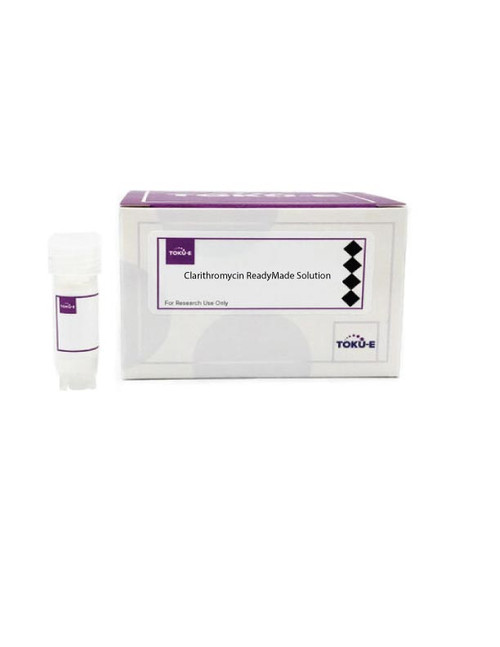Actinomycin D ReadyMade™ Solution is provided as a sterile-filtered solution formulated in DMSO at a concentration of 2 mg/ml.
Actinomycin D is an antineoplastic antibiotic that inhibits cell proliferation by acting as a cytotoxic inducer of apoptosis in tumor cells. It has bacteriostatic activity particularly against Gram-positive bacteria, but its cytotoxicity precludes its use as an anti-infective. Actinomycin D can be used in studies of HIV-replication.
This product is considered a dangerous good. Quantities above 1 g may be subject to additional shipping fees. Please contact us for questions.
We also offer:
- Actinomycin D (A001)
| Mechanism of Action | Actinomycin is a cyclic polypeptide-containing antibiotic that binds to DNA and inhibits RNA polymerase activity. Because Actinomycin can bind DNA duplexes, it can also interfere with DNA replication, although other chemicals such as hydroxyurea are better suited for use in the laboratory as inhibitors of DNA synthesis. Actinomycin D and its fluorescent derivative,7-aminoactinomycin D (7-AAD), are used as stains in microscopy and flow cytometry applications. The affinity of these stains/compounds for GC-rich regions of DNA strands makes them excellent markers for DNA. 7-AAD binds to single stranded DNA; therefore it is a useful tool in determining apoptosis and distinguishing between living and dead cells. |
| Spectrum | Actinomycin D has an inhibitory effect on Gram-positive, Gram-negative bacteria and some fungi. However, its toxicity precludes its use for infectious diseases. |
| Plant Biology Applications | Actinomycin D is used in plant tissue culture to inhibit plant growth through tissue deformation. It also acts as an RNA-synthesis inhibitor. Exposure of Actinomycin D at concentrations of 12-20 ug/ml for 3-4 hours in pea and soybean plants caused significant tissue deformation. |
| Microbiology Applications | The influence of Actinomycin D on the replication of simian rotavirus (SA11) was studied in cell culture with virus-infected MA-104 cells using 1.25 and 2.5 microg/ml of Actinomycin D. Viral RNA replication was not affected by the compound, but increased 3H-uridine uptake was demonstrable by infected cells in the presence of the agent. These data suggest that Actinomycin D may have complexed with viral RNA and prevented newly synthesized mRNA from being translated (Stefanelli et al, 2002). |
| Eukaryotic Cell Culture Applications | Actinomycin D is used as a selection agent in cell culture applications. In a study about induced apoptosis in preimplantation embryos, mouse blastocysts were cultured in vitro with the Actinomycin D apoptotic inductor at various doses and times. It increased cell death incidence in blastocysts in a dose and time-dependent way (Fabian et al, 2007). |
| Cancer Applications | Actinomycin D is used in cancer research for the following: Wilms' tumor, rhabdomyosarcoma, germ cell tumors, gestational trophoblastic disease, Ewing's sarcoma, testicular cancer, melanoma, choriocarcinoma, neuroblastoma, retinoblastoma, uterine sarcomas, Kaposi's sarcoma, sarcoma botryoides and soft tissue sarcoma. |
| Molecular Formula | C62H86N12O16 (Actinomycin D) |
| References |
DJ Morre (1965) Changes in tissue deformability accompanying Actinomycin D inhibition of plant growth and ribonucleic acid synthesis. Plant Physiol. 40(4):615-619 PMID 5826438 Fabian D, Juhás S, Il'ková G, Koppel J (2007) Dose- and time-dependent effects of TNFalpha and Actinomycin D on cell death incidence and embryo growth in mouse blastocysts. Zygote. 15(3):241-249 PMID: 17637105 Stefanelli CC, Castilho JG, Botelho MV, Linhares RE, Nozawa CM (2002) Effect of Actinomycin D on simian rotavirus (SA11) replication in cell culture. Braz. J. Med. Biol. Res. 35(4):445-449 PMID 11960193 |








